The Influence of the Mass Ratio and the Jacobi Constant on the Probability of Escape in the 3D (4+2)-Body Ring Problem
Abstract
1. Introduction
2. Equations of Motion
3. Numerical Analysis of the System
- -
- For and : In Figure 5a, there are a total of 1379 orbits that escape from the potential well. This leads to only of orbits escaping. Upon thorough analysis of the presented data, it becomes apparent that none of the orbits escape within the interval (]. The highest peak of 120 orbits is observed in the interval (]. Afterwards, the number of escaping orbits decreases to 28 in the interval (], and increases again with a secondary peak of 68 orbits in the interval (]. For the next time intervals, the overall pattern of the escaping orbits corresponds approximately to a cyclical behavior, which is distinguished by repeated sequences of ascent and descent to zero with some periods of stability in the escape, in the following intervals: in the interval (], there are 8 escaping orbits; we observe 16 escaping orbits in (]; a total of 32 escaping orbits are identified in the interval , and finally 8 escaping orbits are observed in the interval .
- -
- For and : In Figure 5d, as the diameter of the escape windows increases slightly, we observe notable changes in behavior that correspond to an increase in the number of escaping orbits, with a total of 16,243 orbits. This leads to of orbits escaping. In comparison to the previous patterns, the oscillations no longer display a pattern of decreasing to zero or having periods of stability per intervals of time. It is clear that no orbits escape over the interval (].Furthermore, we identify the highest peak of 716 orbits in the interval (]. Afterwards, the number of escaping orbits decreases to 64 orbits in the interval (], and right after that, the frequency of escaping orbits oscillates in a sequential way.
- -
- For and : In Figure 5g, we detect a total of 39,139 escaping orbits from the potential well. Thus, of orbits escape. There are no escaping orbits on the interval (]. We identify a highest peak of 1164 orbits in the interval (]; after that, there is a sudden decline of 200 orbits in interval (] and a secondary peak of 736 orbits in interval (]. Subsequently, the number of escaping orbits per interval of time continues to show an oscillating pattern.
- -
- For and : In Figure 5j, which corresponds to the scenario with the largest diameter of the exit windows, we observe a total of 88,068 orbits that escape from the potential well. Thus, of orbits escape. There are no orbits that escape over the interval (]. We locate a main peak of 3908 orbits in the interval (]. After a last peak of 1288 escaping orbits in the interval (], we observe a notable gradual reduction in the behavior of oscillations, reaching barely a state of constancy.
- -
- For and : In Figure 5b, we identify a total of 279 orbits that escape from the potential well. Thus, of orbits escape. There are no escaping orbits on the interval (]. There is a highest peak of 64 orbits in interval (] and two secondary peaks of 56 in the intervals (] and (], and the other peaks are in repeated phases of ascending and descending to zero escaping orbits. This particular case exhibits a strikingly distinct sequence with specific peaks that have the same number of orbits throughout various time intervals, i.e., (], (], (] and (].
- -
- For and : In Figure 5e, there are a total of 3603 escaping orbits. Thus, of orbits escape. There are no escaping orbits on the interval (]. After that time interval, smaller peaks begin to emerge, which gradually increase in height until they reach a main peak of 424 orbits in the interval (]. Then, the other peaks decrease slowly till a sudden decline to the lowest peak of 24 orbits in the interval (]. Afterwards, the pattern continues to oscillate.
- -
- For and : In Figure 5h, we detect a total of 7064 orbits escaping from the potential well. Thus, of orbits escape. There are no escaping orbits on the interval (]. The main peak consists of 641 escaping orbits in the interval (]. We observe that the patterns of the peaks exhibit the same behavior shown in Figure 5e, with an increase in the number of escaping orbits related to the expansion of the diameter of the exit windows.
- -
- For and : In Figure 5k, there are a total of 13,877 of orbits that escape from the potential well. Therefore, of orbits escape. There are no escaping orbits over the interval (]. However, the pattern of peaks follows barely the same behavior as in Figure 5h, with a reveal of three discrete peaks, among which the highest peak has 1424 orbits in the interval (].
- -
- For and : In Figure 5c, there are only two orbits that escape from the potential well in the interval (]. We observe a larger interval with no escaping orbits until time units.
- -
- For and : In Figure 5h, we note that there are a total of 159 escaping orbits. Therefore, of orbits escape. There are no escaping orbits over the intervals (] and (]. Then after that, there appear gradually increasing peaks until they reach the main one, with 64 escaping orbits in the interval (]
- -
- For and : In Figure 5i, there are a total of 706 orbits escaping from the potential well. Thus, of orbits escape. We observe a decline in the time intervals that have no escaping orbits, limited only in (] and (]. The main peak has 228 orbits in the interval (].
- -
- For and : In Figure 5l, there are a total of 1952 orbits that escape from the potential well. Thus, of orbits escape. We observe the same pattern as in the previous Figure 5c,f,i with a decrease in the intervals of time that have no escaping orbits, limited in (] and (]. There appear to be four clearly emerging peaks, such that the highest one has 668 orbits in the interval (].
4. Conclusions
Author Contributions
Funding
Data Availability Statement
Conflicts of Interest
References
- Barrabés, E.; Cors, J.M.; Hall, G.R. Numerical exploration of the limit ring problem. Qual. Theory Dyn. Syst. 2013, 12, 25–52. [Google Scholar] [CrossRef]
- Barrio, R.; Blesa, F.; Serrano, S. Qualitative analysis of the (N+1)-body ring problem. Chaos Solit. Fractals 2008, 36, 1067–1088. [Google Scholar] [CrossRef]
- Kalvouridis, T.J. A Planar Case of the n+1 Body Problem: The ’Ring’ Problem. Astrophys. Space Sci. 1998, 260, 309–325. [Google Scholar] [CrossRef]
- Kalvouridis, T.J. Zero-velocity surfaces in the three-dimensional ring problem of N+1 bodies. Celest. Mech. Dyn. Astron. 2001, 80, 133–144. [Google Scholar] [CrossRef]
- Kalvouridis, T.J. Periodic solutions in the ring problem. Astrophys. Space Sci. 1999, 266, 467–494. [Google Scholar] [CrossRef]
- Kalvouridis, T.J. Particle motions in Maxwell’s ring dynamical systems. Celest. Mech. Dyn. Astron. 2008, 102, 191–206. [Google Scholar] [CrossRef]
- Scheeres, D.J. On Symmetric Central Configurations with Application to Satellite Motion About Rings. Ph.D. Thesis, University of Michigan, Ann Arbor, MI, USA, 1992. [Google Scholar]
- Boureghda, Z.; Martínez–Belda, M.C.; Navarro, J.F. Analysis of the geometry of the zero-velocity curves in the N-body ring problem depending on the mass ratio parameter. Eur. Phys. J. Plus. 2024, 139, 69. [Google Scholar] [CrossRef]
- Maxwell, J.C. On the Stability of the Motion of Saturn’s Rings; Macmillan & Company: New York, NY, USA, 1859. [Google Scholar]
- Croustalloudi, M.N.; Kalvouridis, T.J. Regions of a satellite’s motion in a Maxwell’s ring system of N bodies. Astrophys. Space Sci. 2011, 331, 497–510. [Google Scholar] [CrossRef]
- Zotos, E.E. Trapped and Escaping Orbits in an Axially Symmetric Galactic-Type Potential; Publications of ASA: Monroe, MI, USA, 2012; Volume 29, pp. 161–173. [Google Scholar]
- Zotos, E.E. Escape dynamics in a Hamiltonian system with four exit channels. arXiv 2015, arXiv:1511.04889. [Google Scholar]
- Contopoulos, G. Asymptotic curves and escapes in Hamiltonian systems. Astron. Astrophys. 1990, 231, 41–55. [Google Scholar]
- Contopoulos, G.; Kaufmann, D. Types of escapes in a simple Hamiltonian system. Astron. Astrophys. 1992, 253, 379–388. [Google Scholar]
- Navarro, J.F.; Henrard, J. Spiral windows for escaping stars. Astron. Astrophys. 2001, 369, 1112–1121. [Google Scholar] [CrossRef]
- Siopis, C.; Kandrup, H.E.; Contopoulos, G.; Dvorak, R. Universal properties of escape in dynamical systems. Celest. Mech. Dyn. Astron. 1996, 65, 57–68. [Google Scholar] [CrossRef]
- Ernst, A.; Peters, T. Fractal basins of escape and the formation of spiral arms in a galactic potential with a bar. Mon. Not. R. Astron. Soc. 2014, 443, 2579–2589. [Google Scholar] [CrossRef][Green Version]
- Zotos, E.E. Elucidating the escape dynamics of the four hill potential. Nonlinear Dyn. 2017, 89, 135–151. [Google Scholar] [CrossRef][Green Version]
- Zotos, E.E. A Hamiltonian system of three degrees of freedom with eight channels of escape: The Great Escape. Nonlinear Dyn. 2014, 76, 1301–1326. [Google Scholar] [CrossRef]
- Zotos, E.E. Escapes in Hamiltonian systems with multiple exit channels: Part I. Nonlinear Dyn. 2014, 78, 1389–1420. [Google Scholar] [CrossRef]
- Zotos, E.E. Escapes in Hamiltonian systems with multiple exit channels: Part II. Nonlinear Dyn. 2015, 82, 357–398. [Google Scholar] [CrossRef]
- Contopoulos, G.; Efstathiou, K. Escapes and recurrence in a simple Hamiltonian system. Celest. Mech. Dyn. Astron. 2004, 88, 163–183. [Google Scholar] [CrossRef]
- Barrio, R.; Blesa, F.; Serrano, S. Fractal structures in the Hénon-Heiles hamiltonian. Europhys. Lett. 2008, 82, 10003. [Google Scholar] [CrossRef]
- Blesa, F.; Seoane, J.M.; Barrio, R.; Sanjuan, M.A. To escape or not to escape, that is the question—Perturbing the Hénon–Heiles Hamiltonian. Int. J. Bifurc. Chaos Appl. Sci. 2012, 22, 1230010. [Google Scholar] [CrossRef]
- de Moura, A.P.; Letelier, P.S. Fractal basins in Hénon–Heiles and other polynomial potentials. Phys. Lett. A 1999, 256, 362–368. [Google Scholar] [CrossRef]
- Zotos, E.E. Crash test for the Copenhagen problem with oblateness. Celest. Mech. Dyn. Astron. 2015, 122, 75–99. [Google Scholar] [CrossRef]
- de Assis, S.C.; Terra, M.O. Escape dynamics and fractal basin boundaries in the planar Earth–Moon system. Celest. Mech. Dyn. Astron. 2014, 120, 105–130. [Google Scholar] [CrossRef]
- Idrisi, M.J.; Ullah, M.S.; Ershkov, S.; Prosviryakov, E.Y. Dynamics of infinitesimal body in the concentric restricted five-body problem. Chaos Solit. Fractals 2024, 179, 114448. [Google Scholar] [CrossRef]
- Idrisi, M.J.; Ullah, M.S. Out-of-plane equilibrium points in the elliptic restricted three–body problem under albedo effect. New Astron. 2021, 89, 101629. [Google Scholar] [CrossRef]
- Abouelmagd, E.I.; Guirao, J.L. G; Llibre, J. Periodic orbits of quantised restricted three–body problem. Universe 2023, 9, 149. [Google Scholar] [CrossRef]
- Kalantonis, V.S. Numerical investigation for periodic orbits in the Hill three-body problem. Universe 2020, 6, 72. [Google Scholar] [CrossRef]
- Abouelmagd, E.I.; Guirao, J.L.G.; Llibre, J. Periodic orbits for the perturbed planar circular restricted 3–Body problem. Discret. Contin. Dyn. Syst. Ser. B 2019, 24, 1231–1247. [Google Scholar] [CrossRef]
- Abouelmagd, E.I.; Guirao, J.L.G.; Llibre, J. On the periodic orbits of the perturbed two-and three-body problems. Galaxies 2023, 11, 58. [Google Scholar] [CrossRef]
- Kalantonis, V.S.; Ragos, O.; Perdiou, A.E.; Perdios, E.A. Numerical exploration of the Lyapunov families and their spatial bifurcations in the R3BP under the presence of a three–body interaction. Int. J. Non-Linear Mech. 2025, 151, 105152. [Google Scholar] [CrossRef]
- Poincaré, H. Les Méthodes Nouvelles de la Mécanique Céleste; Gauthier-Villars et Fils, Imprimeurs-Libraires du Bureau des Longitudes, de l’École Polytechnique: Paris, France, 1893; Volume 2. [Google Scholar]
- Navarro, J.F.; Martínez–Belda, M.C. Escaping orbits in the N-body ring problem. Comput. Math. Methods 2020, 2, e1067. [Google Scholar] [CrossRef]
- Navarro, J.F.; Martínez–Belda, M.C. On the use of surfaces of section in the N-body ring problem. Math. Methods Appl. Sci. 2020, 43, 2289–2300. [Google Scholar] [CrossRef]
- Navarro, J.F.; Martínez–Belda, M.C. On the analysis of the fractal basins of escape in the N-body ring problem. Comput. Math. Methods 2021, 3, e1131. [Google Scholar] [CrossRef]
- Navarro, J.F.; Martínez–Belda, M.C. Analysis of the distribution of times of escape in the N-body ring problem. Comput. Appl. Math. 2022, 404, 113396. [Google Scholar] [CrossRef]
- Sanchez, D.M.; Deienno, R.; Prado, A.F.; Howell, K.C. Perturbation Maps and the ring of Haumea. Mon. Not. R. Astron. Soc. 2011, 496, 2085–2097. [Google Scholar] [CrossRef]
- Nikaki, A.; Perdiou, A.; Tsirogiannis, G.; Kalantonis, V. Orbital Dynamics at the Equilibrium Points Under Velocity Perturbations in the Crtbp: Application to the Earth–Moon System. Chaos Solit. Fractals 2025, 199, 116651. [Google Scholar] [CrossRef]
- Boureghda, Z.; Martínez–Belda, M.C.; Navarro, J.F. On the analysis of the geometry of escape in the 3D (4+2)-body ring problem. Chaos Solit. Fractals 2024, 187, 115454. [Google Scholar] [CrossRef]
- Arribas, M.; Elipe, A. Bifurcations and equilibria in the extended N-body ring problem. Mech. Res. Commun. 2004, 31, 1–8. [Google Scholar] [CrossRef]
- Salo, H.; Yoder, C.F. The dynamics of coorbital satellite systems. Astron. Astrophys. 1988, 205, 309–327. [Google Scholar]
- Navarro, J.F. Numerical integration of the N-body ring problem by recurrent power series. Celest. Mech. Dyn. Astron. 2018, 130, 16. [Google Scholar] [CrossRef]
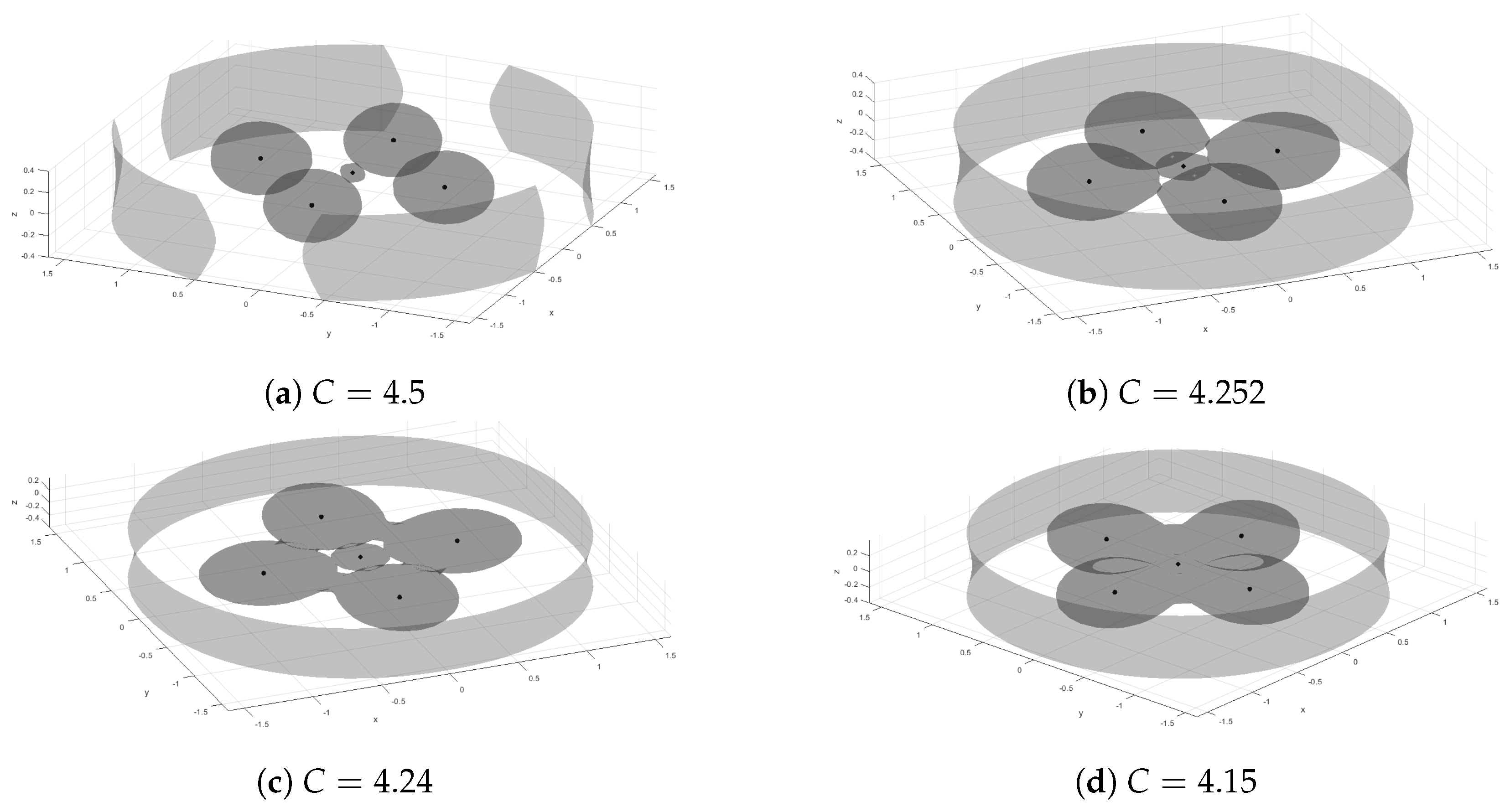


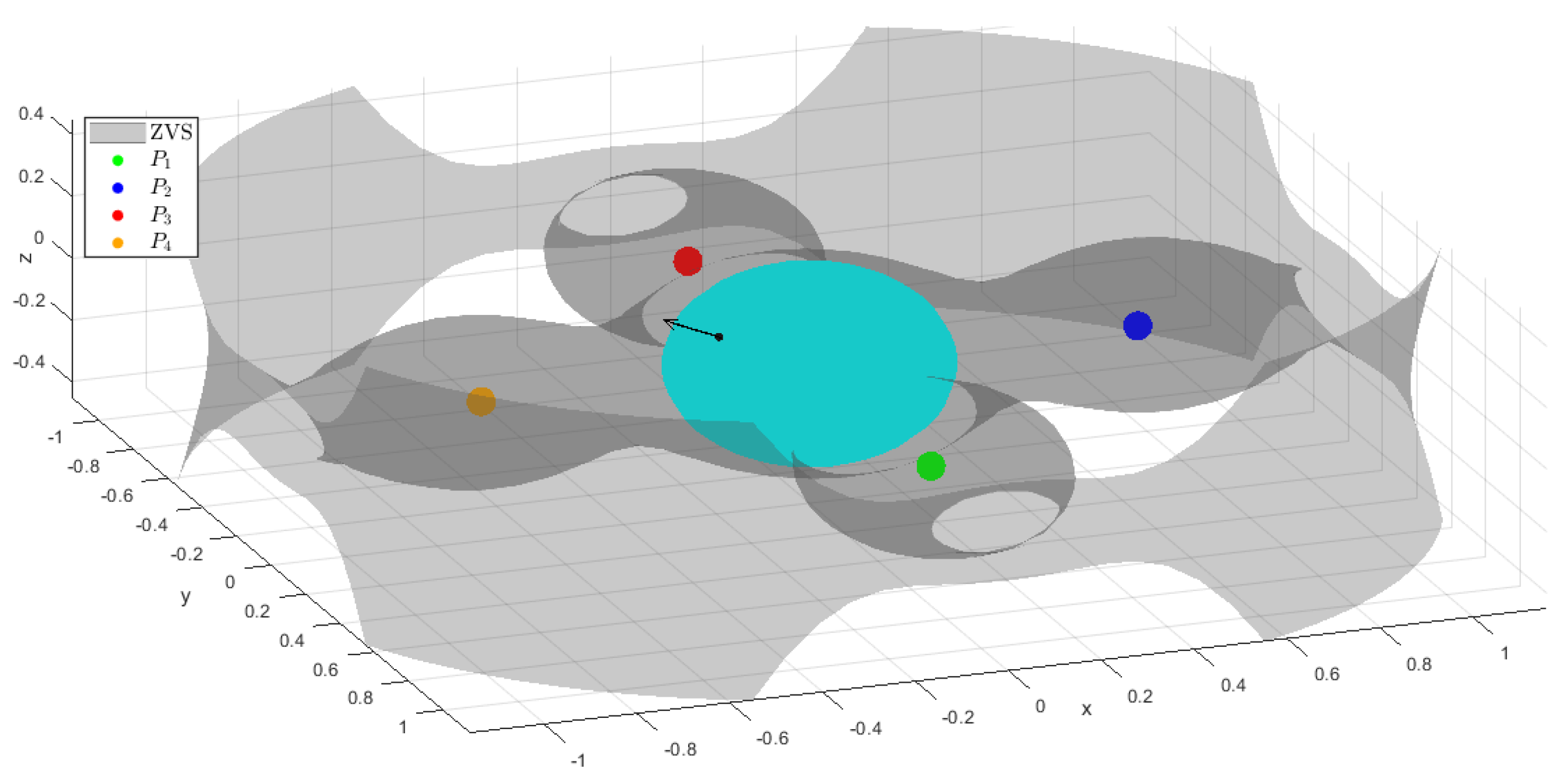


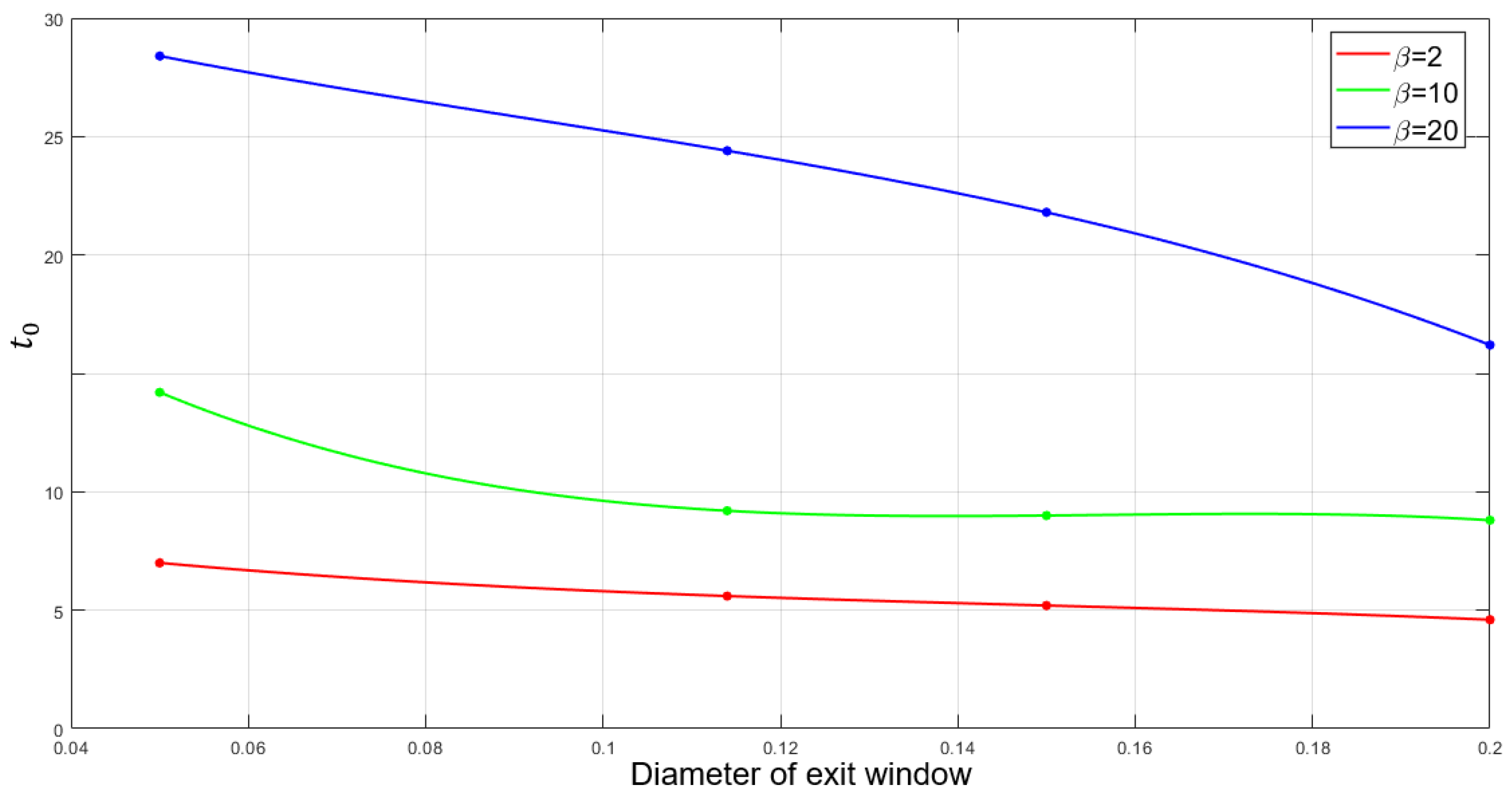
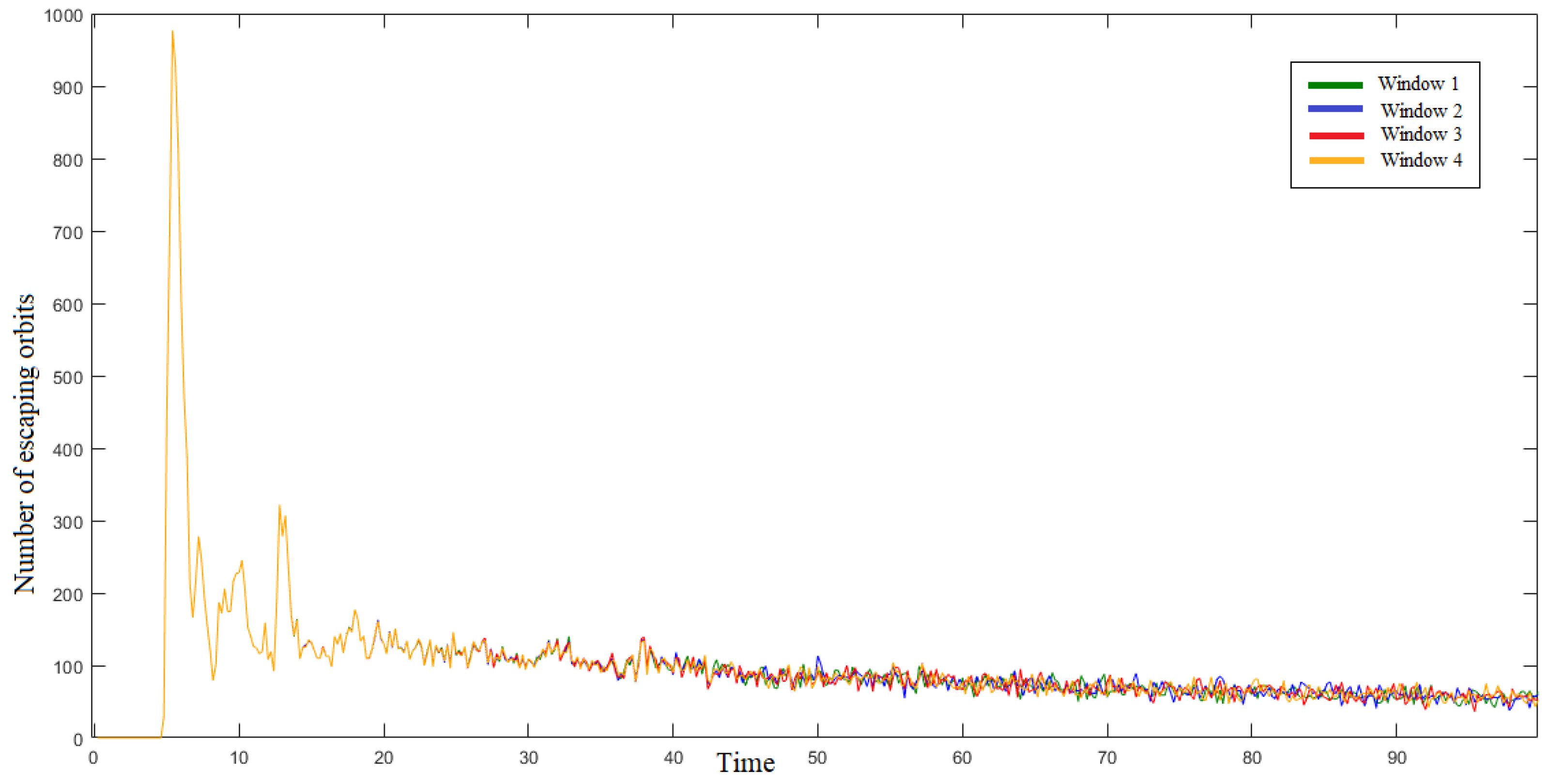
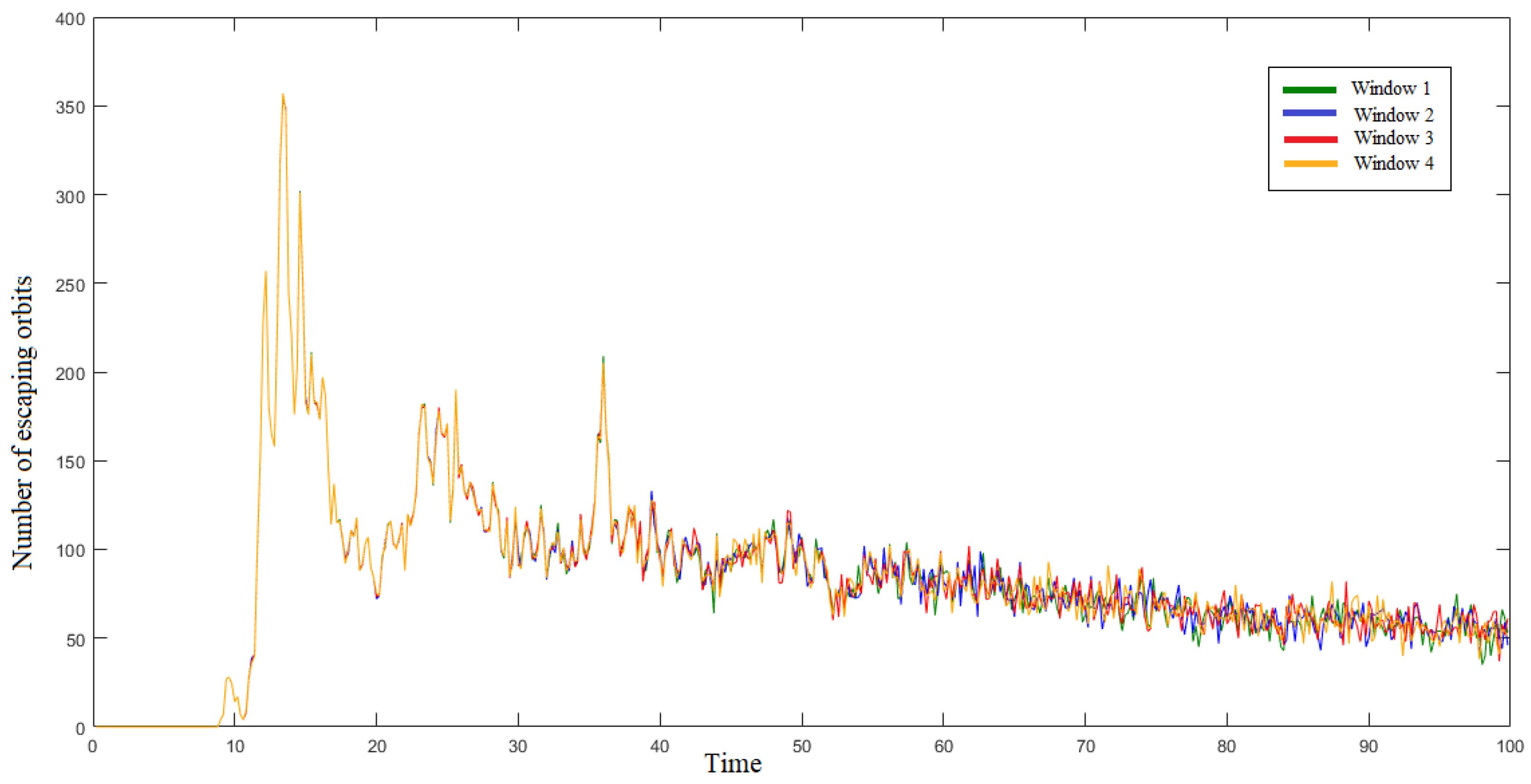

| 2 | |||||
| 10 | |||||
| 20 | |||||
| 0.0 | 0.05 | 0.114 | 0.15 | 0.2 |
| 2 | 10 | 20 | 2 | 10 | 20 | 2 | 10 | 20 | 2 | 10 | 20 | |
|---|---|---|---|---|---|---|---|---|---|---|---|---|
| 5199 | 6127 | 577 | 48,166 | 54,842 | 8666 | 99,329 | 96,201 | 19,488 | 194,647 | 165,908 | 34,892 | |
Disclaimer/Publisher’s Note: The statements, opinions and data contained in all publications are solely those of the individual author(s) and contributor(s) and not of MDPI and/or the editor(s). MDPI and/or the editor(s) disclaim responsibility for any injury to people or property resulting from any ideas, methods, instructions or products referred to in the content. |
© 2025 by the authors. Licensee MDPI, Basel, Switzerland. This article is an open access article distributed under the terms and conditions of the Creative Commons Attribution (CC BY) license (https://creativecommons.org/licenses/by/4.0/).
Share and Cite
Boureghda, Z.; Martínez-Belda, M.C.; Navarro, J.F. The Influence of the Mass Ratio and the Jacobi Constant on the Probability of Escape in the 3D (4+2)-Body Ring Problem. Mathematics 2025, 13, 1992. https://doi.org/10.3390/math13121992
Boureghda Z, Martínez-Belda MC, Navarro JF. The Influence of the Mass Ratio and the Jacobi Constant on the Probability of Escape in the 3D (4+2)-Body Ring Problem. Mathematics. 2025; 13(12):1992. https://doi.org/10.3390/math13121992
Chicago/Turabian StyleBoureghda, Zahra, Mari Carmen Martínez-Belda, and Juan F. Navarro. 2025. "The Influence of the Mass Ratio and the Jacobi Constant on the Probability of Escape in the 3D (4+2)-Body Ring Problem" Mathematics 13, no. 12: 1992. https://doi.org/10.3390/math13121992
APA StyleBoureghda, Z., Martínez-Belda, M. C., & Navarro, J. F. (2025). The Influence of the Mass Ratio and the Jacobi Constant on the Probability of Escape in the 3D (4+2)-Body Ring Problem. Mathematics, 13(12), 1992. https://doi.org/10.3390/math13121992






